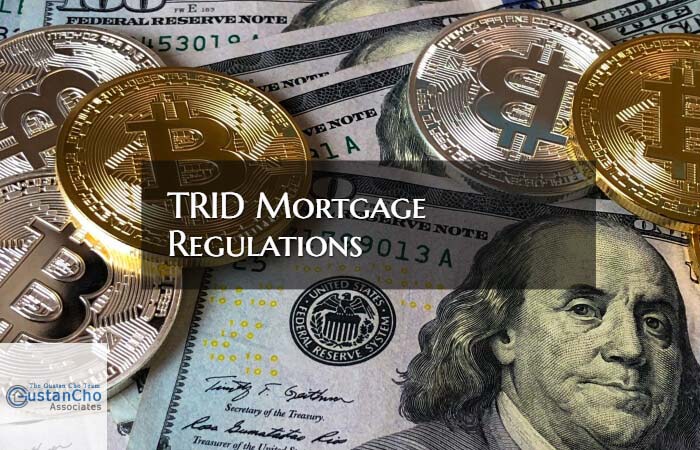TRID Mortgage Regulations For Mortgage Lenders And Borrowers
This BLOG On TRID Mortgage Regulations For Mortgage Lenders And Borrowers Was UPDATED And PUBLISHED On June 10th, 2020
TRID Mortgage Regulations: What Is TRID?
Borrowers going through the mortgage loan application processnow have heard of TRID Regulations that went into effect on October 3rd, 2015.
- The mortgage industry is extremely regulated and once we think that we have more than enough mortgage lending regulations, new changes to mortgage rules are made such as TRID Regulations
- Professional realtors, attorneys, and loan officers already know TRID Regulations
- All borrowers who have applied on or after October 3rd, 2015 need to abide by the new TRID Regulations
- TRID stands for TILA/RESPA Integrated Disclosure Rule
- Many in the mortgage industry were worried about the implementation of TRID and dreading the October 3rd, 2015 initiation date of TRID Regulations
TRID Regulations was created and implemented by the newly formed Consumer Financial Protection Bureau, also known as CFPB, the Sheriff of the Mortgage Industry.
Concerns With TRID
One major concern mortgage industry professionals had with the implementation of TRID Regulations was that implementing and complying with the new TRID Rules could possibly create higher costs to mortgage lenders which in turn will create higher fees and costs to consumers.
- TRID Regulations was created and implemented by the Consumer Financial Protection Bureau, CFPB, to further protect the consumer by making the new disclosures easier to read and to give consumers three business days to review the Closing Disclosure, which replaced the HUD-1 Settlement Statement
- Prior to TRID, once a borrower got a clear to close, or CTC, they could have closed their home loan the same day
- Now, after the clear to close, TRID Regulations mandate that the borrower cannot close their home loan until three business days have elapsed
- This is because the Consumer Protection Financial Bureau feels that the consumer needs the three days to go over the Closing Disclosure and make sure there are no mistakes
If the Closing Disclosure needs changes to be done, the lender needs to correct the items and the file needs to be re-disclosed to borrowers and they need to wait an additional three business days.
Critics Of TRID
Critics of the TRID Regulations are already complaining that the three day waiting period is hurting consumers than helping then.
- Costs and fees are escalating for lenders where it gets trickled down to consumers
- Many mortgage and real estate industry professionals and experts stand by their belief that the new TRID Regulations will greatly slow down the mortgage process of closing on both home purchase mortgage loans and refinance mortgage loans
- Rush closings will become non-existent under the new TRID Regulations since it is mandatory that home buyers need to wait a mandatory three business days after a clear to close and getting their Closing Disclosure
- Prior to TRID, most home purchase loans were able to be closed in 30 days or less
- However, with the new TRID Mortgage Regulations, the three day waiting period can turn into weeks in the event if the mortgage loan file needs to be re-disclosed
- Prior to TRID, if there was a change of circumstances or changes needed to be made, it could have been done on the spot
However, with new TRID RULES, this cannot be done and a new Closing Disclosure needs to be re-disclosed and the borrower needs to wait 3 days from the receipt of the latest Closing Disclosure.
Outcome Of TRID Regulations
The first batch of TRID loans is now closing and lenders are getting accustomed to it and so are title company closers and real estate attorneys. The outcome of TRID Regulations has combined and has simplified the initial various forms and disclosures that mortgage companies had used prior to the implementation of TRID. The main goal of TRID rules and regulations by the Consumer Protection Financial Bureau was for consumer protection by creating a more consumer user-friendly Loan Estimate also referred to as LE which allows mortgage loan borrowers to understand the terms of their mortgage loans. As time progresses, home buyers, home sellers, real estate attorneys, title companies, and mortgage loan originators will get accustomed to the new TRID Regulations and the old Good Faith Estimate and HUD-1 Settlement Statements will be a thing of the past and forgotten.
Mortgage And Banking Regulations created financial responsibility.
- When investors tried to sell the American dream of homeownership and put the pressure on banks and lenders to change responsible regulation in order to sell more, that caused the imbalance.
- People who normally wouldn’t qualify were now qualifying without proof of income.
- Mortgage lenders qualified home buyers for far more than they could actually afford.
- Lenders put home buyers in products that they didn’t understand such as Adjustable Rate Mortgages and teaser rate mortgages
- Also called negative amortization mortgages where the initial payment might be $1,000 per month and once the adjustment period begins, it can jump to double the original amount or more.
Creation Of New Mortgage And Banking Regulations
These mortgage products were the initiation of the mortgage meltdown in this country where foreclosures spread like wildfire starting in early 2007.
- The frenzy feed the vicious beast and people didn’t care because they thought the good days would never end
- Many made money flipping homes in 6 months or less and everyone wanted in on the action until it all came to an end
- There were areas in Chicago and other parts of the country where new construction property changed hands more than a dozen times before the end purchaser purchased it at a high premium
- Real estate prices were appreciating double digits in most parts of the country and every vacant parcel was being developed
- Wanna be real estate investors were purchasing any property that came on the market and tearing them down and rebuilding in hopes of selling them at double-digit profits
- Folks who got started in the flipping game early on became instant multi-millionaires until the real estate and credit meltdown of 2007
Understanding New Mortgage And Banking Regulations
Understanding what goes on behind the scenes is a complicated web.
- Everyone from the consumer to the government was making huge money during this time and that is why the government was so slow to make changes
- Regulation failed and now to correct the mistakes, the government swings too hard the opposite way to correct
Overhaul Of Mortgage And Real Estate Industry
New Mortgage And Banking Regulations have been created and implemented and now all mortgage loan originators need to get licensed and undergo strict criminal and financial background checks.
- The SAFE ACT was created and many government regulatory agencies were created to minimize fraud in the mortgage industry.




